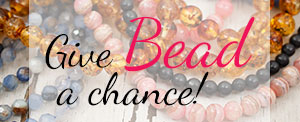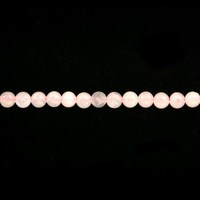Beader’s dictionary
A
AGATE (See products)
Agate is gemstone of the quartz family. It is a kind of ribboned calcedony with concentric layers. The agate is a very shiny stone when polished and is available in a number of colors and patterns: yellow agate, moss agate, etc. Up to the XIXth century, it was widely used for cameos.
Agates can be found in South America, in the United States, Australia, India, China and Africa.
A little bit of history: it is believed that the stone got its name out of the Achates river, where many of them were found in Ancient Rome. It is also believed that its name could derive from an Arabic word that refers to a new-born’s hair.
AMETHYST (See products)
Amethyst is a purple to light crimson gemstone of the quartz family. Its name derives from the Greek amethystos meaning "not drunk." Indeed, it was regarded as a talisman against intoxication during Antiquity. The coloring of the amethyst is due to the presence of iron and high irradiation. Amethyst darkens slightly and gradually in the presence of artificial light, and some can fade in the daylight.
The main countries where amethyst is found are Brazil, Madagascar, Mexico, Canada, the United States, Sri Lanka, Zambia, Myanmar, Uruguay, India, Namibia and Russia.
A little bit of history: In Classical (Greco-Roman) mythology, Amethyst was a young nymph who was transformed into a crystal by the goddess Diane, in order to protect her from Bacchus, the god of wine. Furious, the god is said to have poured his cup of wine on the crystal, giving it its color. The notion that amethyst prevents drunkenness comes from this legend.
AVENTURINE (See products)
The aventurine, or aventurine quartz, is a stone of the quartz family. It can be found in several shades of colors, ranging from green (due to the presence of fuschite) to brownish-red (due to the presence of hematite). Significant deposits are found in Brazil, India, Russia and Tanzania.
C
Cat-eye glass
Synthetic cat’s eye is made of optical fibers. The same as the ones used in telecommunications. The goal is to make with the glass the same chatoyant effect as the natural cat’s eye, a well known gemstone. The optical fibers (made of quartz fibers) are merged and coated with colorful glass.
CHALCEDONY (See products)
The term chalcedony designates all varieties of quartz and microcrystalline and cryptocrystalline. It includes agate, carnelian, jasper, onyx and other varieties of quartz. However, the term chalcedony is often used to denote the common chalcedony sensu stricto. It can have a milky appearance and be transparent, and bluish white-grey.
It can be dyed as it is porous. It can be found in Brazil, the United States, India, Madagascar, Namibia, Sri Lanka and Zimbabwe.
A little bit of history: The name comes from the Greek "Karchêdôn", an ancient transit city on the Bosphorus (Istanbul strait). Roman and Egyptian used it in cameos, seals and amulets. Today, it is often found in the form of a cabochon, as beads, rings or artifacts. In the Neolithic period, chalcedony was used to make tools.
CITRINE
Citrine is a glassy yellow to brown colored gemstone of the quartz family. It actually is a silicon dioxide (silica). Its yellowish color is due to the presence of a very small amount of iron oxides in the mineral. Its name is derived from the lemon of which she shares the yellowish shade. Natural citrines are rare. Most of them originate from Brazil, the United States, Madagascar, Argentina, Myanmar, Scotland, Spain, Namibia and Russia.
G
GEMSTONES (See products)
They used to be known as semi-precious stone, however, this appellation was revoked because it was considered pejorative. Gemstones (also fine gem or gem) are translucent or transparent (topaz, quartz, opal, etc.). The following stones are classified as gems: amber, aquamarine, amethyst, citrine, rock crystal, cordierite, garnet, peridot, tanzanite, topaz, tourmaline and zircon.
There are also ornamental stones such as lapis lazuli and turquoise, which are often mistaken as gemstones. This term generally designates opaque colored stones or stones of a lesser value.
The reconstituted stones are manufactured by a process that reduces useless stones to a powder, the powder is then mixed with glue. Thus making a complete stone. Dyes can be added to give a certain uniformity to the stone's appearance.
The term stabilized means that a natural stone, such as turquoise, was too porous and has been dipped in a resin bath, or into another protective lacquer, to solidify.
In France, the only stones said to be precious are diamonds, sapphires, emeralds and rubies. Around the world, this term refers to any gem of great value.
J
JASPER (See products)
Jaspers are precious stones that are part of the quartz family. Jaspers are opaque stones that are available in many colors and are usually freckled, striped or multicolored. Monochromatic jaspers are extremely rare. Jaspers are often found as cabochons, beads or used to create art pieces or mosaics.
There are various types of Jaspers; the picture jasper which has a sand color veined with brownish-black, the mookaite which is found in shades of pink to dark red, the leopard skin jasper which is spotted, the orbicular jasper which is sprinkled with circular spots that range from beige to black, the dalmatian jasper that is beige with black spots, the jaspagate (also agate jasper) which is yellow, brown or green mixed with agate, the stratified ribboned jasper that comes in various colors, the sanguine jasper or heliotrope which is dark green with red accents. The main deposits are found in Australia, Brazil, Canada, Egypt, in the United-States, in India, Kazakhstan, madagascar, Russia and Uruguay.
O
ONYX (See products)
Onyx is a ribboned gemstone of the Quartz family and of the chalcedony variety. It has colored layers. Real Onyx has a base layer that is black, overlapped with a white layer. The term onyx can also be used to identify a monochromatic chalcedony (like black onyx) not to be confused with marble-onyx (calcareous onyx) that is often referred to as black onyx.
Onyx is often used to make cameos because it allows for the cutting of a pale layer over a darker one. Onyx is often found in cabochons but may be facetted as well. It can also be found as a reconstituted stone.
Q
QUARTZ
The term "quartz" refers to a family of minerals within the group of silicates. Quartz composes 12% of the lithosphere (outermost shell) and is the most common mineral. Quartzs are divided into different categories, among them the macrocrystalline quartz (amethyst, citrine, rock crystal, quartz smoke, rose quartz, blue quartz, quartz cat-eye, iron-eye, falcon-eye and tiger-eye ) and microcrystalline quartz (chalcedony, carnelian, onyx, agate, chrysoprase, jasper and petrified wood).
R
RHINESTON (See products)
Rhinestones are originally rock crystals (translucent quartz) from the banks of the Rhine river, in Germany.
In 1775, the Alsatian jeweler Georg Friedrich Strass had the idea to coat these crystals with metal powder, to increase their refraction. The result provided an excellent and inexpensive replica to diamonds. The name of their inventor is also used to designate rhinestones : Strass.
With the evolution of technology, rock crystals were replaced by lead crystal. Swarovski is the largest producer of synthetic rhinestones. In 1955, with the advent of Aurora Boreal reflection (AB), rhinestones benefited from the discovery as well. It is now possible to see the rhinestone with a rather silvery colored shine or AB reflection.
The rhinestone was dethroned as the best diamond replica by the creation of cz (cubic zirconia) in 1980, but it held its own in the fashion and jewelry industries.
Rhinestones can be facetted then glued or set on a jewel or a string. Nowadays, colorful rhinestone that imitate precious or semiprecious stones can be purchased at an affordable price.
Rhinestone have several aliases : strass and glitter diamond amongst others. In fashion jewelry, they are often found as chains, separators or metal beads.
T
TIGER EYE
Tigers eye is an opaque stone that comes from the yellow gold to brown quartz family, it is characterized by its chatoyancy; a rippling chatoyant reflection. Its color can be attributed to iron. Its name is derived from the fact that when cut in cabochon, the chatoyancy of the stone recalls that of the similarly named feline. Tigers eye can be painted in any color just like the red tigers eye. Deposit are found mostly in South Africa, Australia, Myanmar, in The United-States, In India as well as in Namibia.
U
UNAKITE (See products)
L’unakite is a precious stone from the garnet family. Of an irregular aspect, it is an opaque stone, green in color with sprinkles of salmon pink. It can also have shades of orange, beige or other nuances of green and pink. It is mainly made of quartz, feldspath and green epidote. Its name is derived from a deposit in California (Unaka Range). It is often found in decorative objects, cut in cabochon or as beads.
Z
ZODIAC STONES
During Antiquity as well as Middle-Ages, it was believed that the formation of gems was influenced by constellations, some gems were as bright as stars. They were thought to be the mirrors of the cosmos. Therefore each planet was associated with one or more gems that possess “magical” properties. These beliefs still circulate in todays modern society, even though there are no tangible proof to support them.
| Sign | Stones |
|---|---|
| ARIES | Carnelian, red jasper |
| TAURUS | Carnelian, pink quartz |
| GEMINI | Citrine, tiger's eye |
| CANCER | Chrysoprase, aventurine |
| LEO | Rock crystal, golden quartz |
| VIRGO | Citrine, yellow agate |
| LIBRA | Orange citrine, smoked quartz |
| SCORPIO | Blood red Carnelian |
| SAGITTARIUS | Sapphire, chalcedony |
| CAPRICORN | Onyx, rutilated quartz |
| AQUARIUS | Turquoise, falcon eye |
| PISCES | Amethyst, quartz amethyst |























